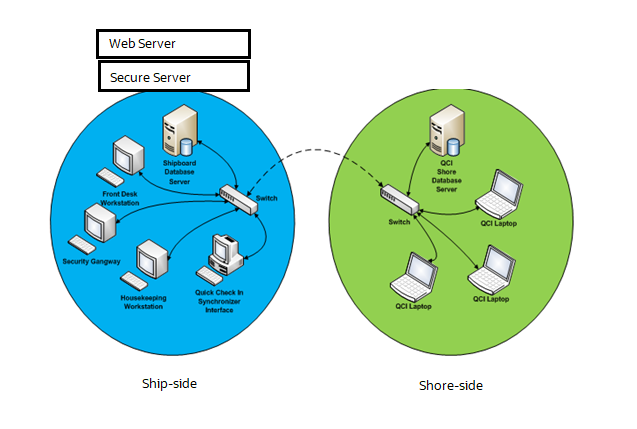7 Setting Up SPMS QCI Offline Operation
In SPMS, there is a feature that allows the shoreside client machines to continue operating in real-time, even in an off-line mode, where there is no connection to the shipside SPMS Database Server.
Figure 7-1 SPMS QCI Offline Operation

To support this, you need an additional Database Server that must be placed on the shoreside, as depicted in the diagram above. On the shore-side, only the Database Server is required. SPMS Web Server and Secure Server do not to be placed on the shoreside.
Prerequisites
-
The version of Oracle Database Edition of the QCI Shore database and Ship database must be identical. For example; if the ship is running on Oracle 12c R2 then the shore QCI database must also run on Oracle 12c R2.
-
Both the Ship database and the QCI Shore database password must be identical. If a different password is used, the connection will show Disconnected.
-
On the Shore side, the TNS name used to reference the QCI Shore database must be identical to the TNS name used on Shipside to reference the Shipboard database.
Setting Up QCI Shore Database
To set up the QCI Shore database, See topic Setting Up SPMS Database Server. The steps are similar to the setup of the shipside SPMS Database. When setting up the QCI Shore Database, the TNS name used to point to the QCI Shore Database must be the same as the TNS name used on the shipside to point to the shipboard SPMS Database. This is important because the SPMS clients on the shore-side will obtain the database password from the Secure Server hosted on the shipside when there is network connectivity before going offline. This also explains why the QCI Shore database password and Ship database password have to be the same.
Note:
When setting up to the database on the shoreside, use the same TNS name and DB Password as the ship application. For example, if the TNS name “SPMSv8DB” is used at the shipside to connect to the Ship database, then you must use the same TNS name “SPMSv8DB” at the shoreside for the QCI Shore database.
This allows any QCI laptop to obtain the database password from the Secure Server at the shipside and write to the database when there is a network connection.
Setting Up QCI Shore SPMS Application Client
As depicted in Figure 7-1, the QCI laptops must connect to the QCI Shore Database to operate. To set up the QCI Shore SPMS Application Client, see topic SPMS Desktop Application Clients Installation Steps.
When setting up, the TNS name pointing to the QCI Shore Database must be the same as the TNS name used on the shipside to connect to the shipboard SPMS Database. On the SecureLogin.txt file, the IP of the Secure Server on shipside must be added to allow the QCI laptop to request the database password from the Secure Server of the ship if it has not received a copy of the database password stored on the local DPAPI protected OHCSecurity.par file. Prior to going offline, when there is network connectivity, the user should ensure that the database password is stored on the local DPAPI protected OHCSecurity.par file.
Note:
SPMS Application Client on the QCI laptops can connect to multiple Databases, whether hosted on shipside or shoreside. You can set up the TNS for each of the Databases using the OHC Tools. See topic: Connecting to Different SPMS Database using Different TNS.
Setting Up Shipside QCI Synchronization Interface
As depicted in Figure 7-1, a shipside machine is dedicated to run the QCI Synchronization Interface. To set up the QCI Synchronization Interface, see topic SPMS Desktop Application Clients Installation Steps. The SPMS QCI Synchronization Interface requires connection to both the Ship database and QCI Shore Database. Therefore, the TNS Name used for the Ship database and QCI Shore Database must be different in this local machine.